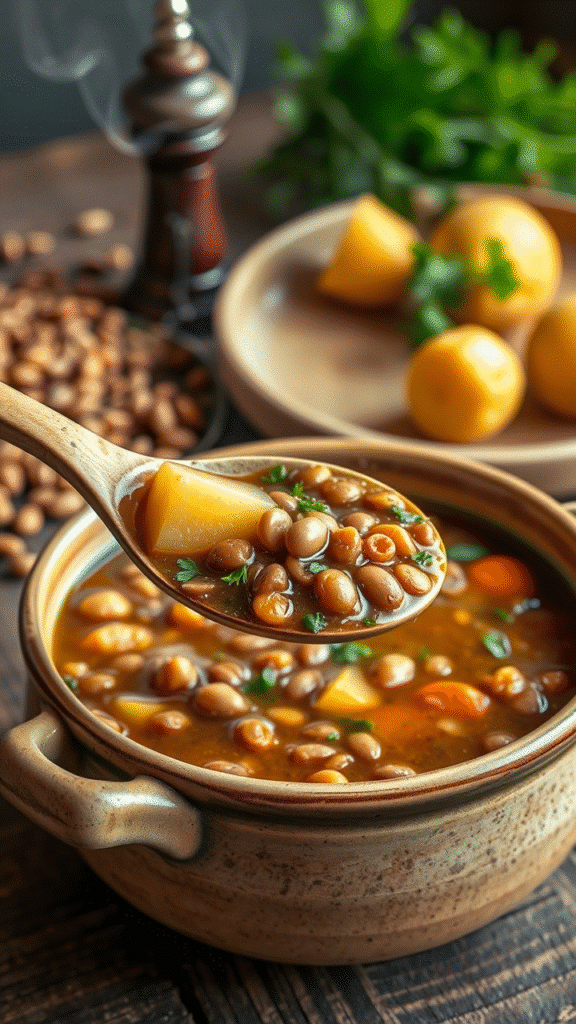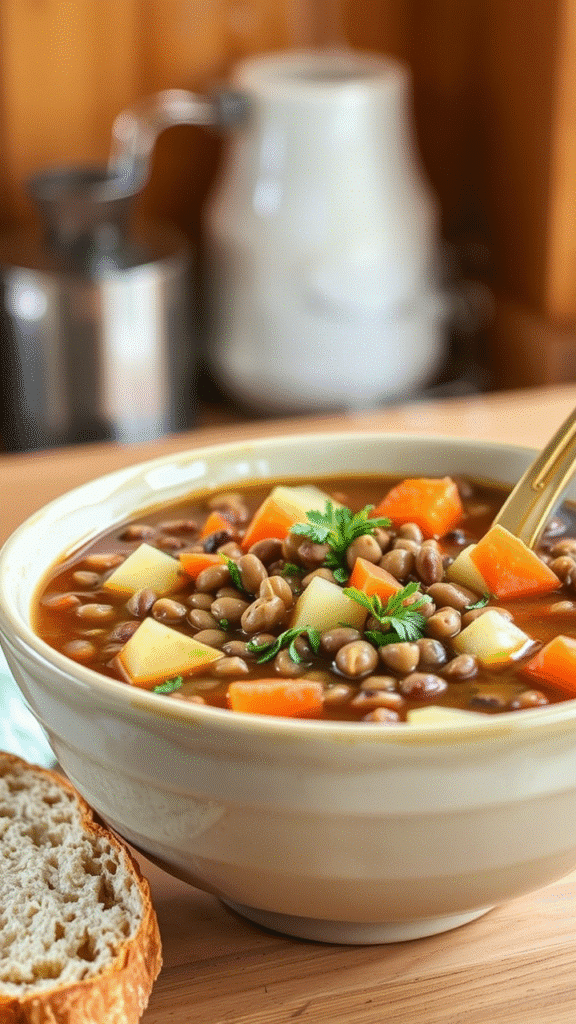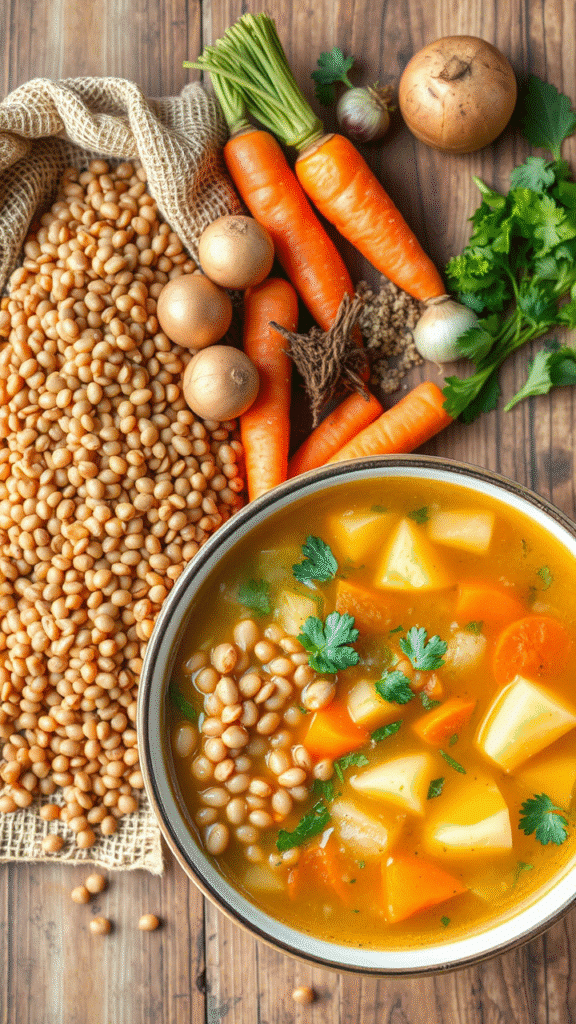Last winter, during a particularly brutal cold snap in the restaurant kitchen, I watched our sous chef prepare what would become our most requested comfort dish. Steam rose from the stockpot like incense, carrying the earthy aroma of red lentils mingling with golden potatoes. That’s when I realized something profound about this humble soup it possesses an almost mystical ability to transform simple pantry staples into liquid comfort.
This isn’t just another vegetarian soup recipe. It’s a masterclass in building layers of flavor through technique, timing, and the sacred marriage of protein-rich legumes with starchy potatoes. What makes this particular version extraordinary is how it achieves restaurant-quality depth using ingredients you probably already have at home.
The cultural significance runs deep too. Variations of lentil and potato soup appear across continents from Indian dal to Middle Eastern shorbat adas to European peasant stews. Each culture has discovered this magical combination independently, which tells you everything about it’s inherent brilliance.
Ingredients & Substitutions
The Foundation Trinity
Start with one large yellow onion, finely diced. Yellow onions provide the perfect balance of sweetness and pungency that red onions can’t match here. If you’re stuck with red onions, use about three-quarters the amount—they’re more assertive.
Two medium carrots, diced to roughly the same size as your onion pieces. This isn’t just for color; carrots contribute natural sugars that caramelize during the sautéing process. Parsnips make an excellent substitute and add a subtle spicy note that elevates the entire dish.
Three celery stalks, including the leaves if they’re fresh. Don’t waste those leaves they pack more flavor than the stalks themselves. Fennel bulb can substitute beautifully here, bringing an anise note that’s surprisingly complementary.
The Protein Powerhouse
One and a half cups of red lentils form the heart of this soup. Red lentils break down completely during cooking, creating a creamy base without any dairy. Green or brown lentils won’t work the same way they’ll maintain their shape and give you a completely different texture profile.
If red lentils aren’t available, split yellow peas create a similar effect, though they’ll need about ten minutes longer cooking time. Even yellow split mung beans work wonderfully, particularly if you’re aiming for a more South Asian flavor profile.
The Starchy Comfort
Two pounds of Yukon Gold potatoes, peeled and cut into half-inch cubes. Yukon Golds are non-negotiable here their creamy texture and buttery flavor surpass russets or red potatoes significantly. Russets will fall apart too much, while red potatoes stay too firm and waxy.
For those avoiding nightshades, cubed butternut squash or even cauliflower can substitute, though you’ll lose some of the hearty satisfaction that only potatoes provide.
The Flavor Builders
Four garlic cloves, minced finely. Fresh garlic is essential granulated garlic powder simply can’t replicate the aromatic compounds that develop when fresh garlic hits hot oil. If you’re preparing this for someone with garlic sensitivities, try asafetida powder instead just a pinch will do.
One tablespoon of tomato paste adds umami depth that transforms the entire soup. Don’t skip this ingredient thinking it won’t matter. That concentrated tomato flavor provides the backbone that holds all other flavors together.
Two teaspoons each of ground cumin and coriander create the spice foundation. Toasting whole seeds and grinding them yourself makes a noticeable difference, but good quality pre-ground spices work perfectly well. Smoked paprika can substitute for regular paprika if you want to add another layer of complexity.
The Liquid Base
Six cups of vegetable broth form the cooking medium. Homemade stock is ideal, but high-quality store-bought versions work excellently. Chicken broth can substitute if you’re not maintaining a vegetarian profile it’ll add richness but change the character somewhat.
One 14-ounce can of diced tomatoes brings acidity and additional umami. San Marzano tomatoes are worth the extra cost if you can find them. Their lower acidity and sweeter flavor profile makes them superior to regular canned tomatoes.
Step-by-Step Instructions

Building the Aromatic Base
Heat three tablespoons of olive oil in a heavy-bottomed Dutch oven over medium heat. The oil should shimmer but not smoke if it’s smoking, your heat is too high and you’ll burn the aromatics before they properly caramelize.
Add the diced onions with a generous pinch of salt. The salt draws out moisture immediately, helping the onions soften more quickly. Cook for about five minutes, stirring occasionally, until they’re translucent but not browned. You want sweetness, not caramelization at this stage.
Add carrots and celery, cooking for another four minutes. Listen for the gentle sizzling if the pan goes quiet, increase the heat slightly. This sautéing process is critical for developing the soup’s flavor foundation.
The Aromatics Dance
Push vegetables to one side of the pot and add minced garlic to the cleared space. This technique prevents the garlic from burning while still allowing it to bloom in the hot oil. Cook for thirty seconds until fragrant any longer and you risk bitterness.
Stir in tomato paste, cooking for another minute until it darkens slightly. This step cooks out the raw tomato flavor and concentrates the umami compounds. The paste should sizzle and darken, but watch carefully to prevent burning.
Add cumin, coriander, and paprika, stirring constantly for thirty seconds. The spices should become aromatic immediately if they don’t, your pan isn’t hot enough. This blooming process releases essential oils that remain locked in ground spices otherwise.
Building the Soup Body
Pour in the diced tomatoes with their juice, scraping up any browned bits from the bottom of the pot. These fond particles contain concentrated flavor that you don’t want to waste.
Add the vegetable broth, bring to a boil, then reduce to a gentle simmer. The surface should barely bubble a rolling boil will make the lentils mushy and the potatoes grainy.
Stir in the red lentils, making sure they’re fully submerged. Red lentils cook quickly and can stick to the bottom if not stirred properly. Simmer for fifteen minutes, stirring occasionally.
The Potato Addition
Add the cubed potatoes to the pot, ensuring they’re covered by liquid. If needed, add more broth or water. The potatoes need to cook evenly, which requires complete submersion.
Continue simmering for another fifteen to twenty minutes, until potatoes are fork-tender and lentils have completely broken down. The soup should be thickening naturally as the lentils dissolve.
Taste and adjust seasoning with salt and black pepper. Remember that the flavors will concentrate slightly as the soup cools, so season accordingly.
Cooking Techniques & Science

Understanding Lentil Behavior
Red lentils are hulled and split, which means they cook much faster than whole lentils. The lack of seed coat allows them to absorb liquid quickly and break down completely, creating a naturally creamy texture without any dairy additions.
This breakdown process is actually a form of controlled disintegration. The lentil starches gelatinize and create a thickening effect similar to what happens when you make a roux, but without the need for flour or butter.
The Potato Science
Yukon Gold potatoes contain the perfect balance of starch and moisture for soup applications. Their medium starch content means they’ll soften and become creamy without completely falling apart like russets would.
The key is adding them at the right moment too early and they’ll overcook into mush, too late and they won’t absorb the flavors properly. The fifteen-minute mark after the lentils have started breaking down is the sweet spot.
Heat Control Mastery
Maintaining a gentle simmer rather than a rolling boil serves multiple purposes. Aggressive boiling breaks down the vegetables too quickly, creating an unpleasant texture. It also causes excessive evaporation, concentrating flavors too much and potentially making the soup too salty.
The gentle bubbling allows flavors to meld gradually while preserving the integrity of the potato pieces. Professional kitchens understand that patience in simmering creates superior results to high-heat rushing.
The Maillard Advantage
That initial sautéing of the aromatics isn’t just about softening vegetables it’s about creating Maillard reactions that generate complex flavor compounds. When onions, carrots, and celery hit hot oil, hundreds of different chemical reactions begin producing the savory notes that make this soup so satisfying.
Even the brief cooking of the tomato paste contributes to this process. The concentrated sugars in tomato paste caramelize slightly, adding depth that raw paste simply cannot provide.
Serving & Pairing Suggestions

Presentation Excellence
Ladle the soup into warmed bowls cold bowls will cool the soup too quickly and diminish the eating experience. A drizzle of good olive oil creates both visual appeal and a layer of richness on the surface.
Fresh herbs make all the difference in presentation. Chopped parsley adds color and freshness, while cilantro brings a bright, citrusy note. For something more sophisticated, try a few leaves of fresh thyme or a sprinkle of smoked paprika.
A dollop of Greek yogurt or sour cream provides temperature contrast and cuts through the earthiness beautifully. For vegan presentations, cashew cream or a swirl of coconut milk works wonderfully.
Bread Pairing Perfection
Crusty sourdough bread is the classic accompaniment, but consider naan bread for a more international approach. The yogurt and leavening in naan complement the soup’s earthy flavors perfectly.
For something more refined, try grilled halloumi cheese on toasted pita. The salty, squeaky cheese provides textural contrast while the pita offers a vehicle for scooping.
Wine and Beverage Pairings
A medium-bodied red wine like Côtes du Rhône or Grenache complements the earthy lentils without overwhelming the delicate potato flavors. For white wine lovers, a rich Chardonnay or Viognier provides enough body to match the soup’s heartiness.
Beer pairings work exceptionally well too. Belgian-style wheat beers bring out the soup’s comfort-food qualities, while brown ales echo the earthy, roasted notes from the sautéed vegetables.
Conclusion
This hearty lentil and potato soup represents everything beautiful about simple, honest cooking. It transforms humble ingredients into something greater than the sum of it’s parts through proper technique and patience.
The key lies in understanding that each step builds upon the previous one. The aromatic base creates the foundation, the protein and starch provide substance, and the gentle simmering allows everything to harmonize into comfort in a bowl.
Remember that great soup isn’t just about following a recipe—it’s about tasting, adjusting, and understanding how flavors develop over time. Trust your palate, embrace the process, and don’t rush the simmering stage.
This soup improves with time, making it perfect for meal prep or feeding a crowd. Store it in the refrigerator for up to five days, adding a splash of broth when reheating to restore the proper consistency.
Frequently Asked Questions?
Q: Can I make this soup in a slow cooker or instant pot?
A: Absolutely! For slow cooker preparation, sauté the aromatics first in a skillet, then transfer everything to the slow cooker and cook on low for 6-8 hours. For Instant Pot, use the sauté function for the aromatics, then pressure cook on high for 12 minutes with natural release. The texture will be slightly different but equally delicious.
Q: Why does my soup become too thick after storing?
A: Lentils continue absorbing liquid even after cooking, and the starches thicken further as the soup cools. This is completely normal. Simply add vegetable broth or water when reheating, starting with small amounts until you reach the desired consistency. The flavors will be even more developed after sitting overnight.
Q: Can I freeze this soup, and how long will it keep?
A: This soup freezes beautifully for up to three months. The potatoes may change texture slightly after freezing, becoming a bit more mealy, but the overall flavor remains excellent. Freeze in portion-sized containers and thaw in the refrigerator overnight before reheating. Add liquid as needed when reheating.
Q: What’s the best way to add more protein to this soup?
A: For additional protein, consider adding cooked sausage during the last ten minutes of cooking, or stir in some cooked ground turkey or beef. For vegetarian options, a handful of spinach or kale in the final minutes adds nutrition, or try adding some cooked white beans alongside the lentils for extra protein and fiber.
Q: My soup tastes bland despite following the recipe exactly. What went wrong?
A: Under seasoning is the most common issue with lentil soups. Lentils absorb a lot of salt, so you’ll need more than you might expect. Also, make sure you’re tasting and adjusting seasoning at the end of cooking. A splash of lemon juice or vinegar can brighten flavors dramatically. Finally, check that your spices are fresh old spices lose potency and won’t provide the flavor impact you need.

Veronica is a passionate food enthusiast with over three years of experience in exploring and writing about diverse cuisines. Her expertise lies in reviewing restaurants, sharing creative recipes, and discovering the latest food trends. As the voice behind FoodieRecap.com, Anju brings fresh perspectives and culinary insights to her audience.
